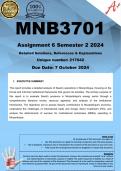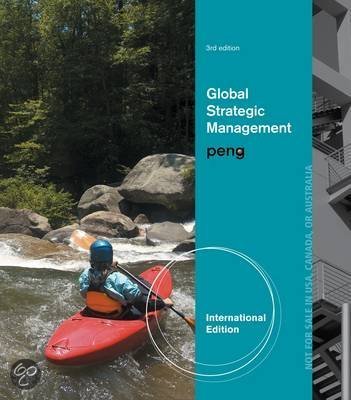MNB3701
Assignment 6 Semester 2 2024
Detailed Solutions, References & Explanations
Unique number: 217042
Due Date: 7 October 2024
1. EXECUTIVE SUMMARY
This report provides a detailed analysis of Sasol’s operations in Mozambique, focusing on the
formal and informal institutional frameworks that govern its activities. The primary purpose of
this report is to evaluate Sasol's presence in Mozambique's energy sector through a
comprehensive literature review, resource appraisal, and analysis of the institutional
frameworks. The objectives are to assess Sasol's contributions to Mozambique's economy,
understand the challenges of international trade and foreign direct investment (FDI), and
analyze the determinants of success for multinational enterprises (MNEs) operating in
Mozambique.
Key findings indicate that Sasol has played a significant role in Mozambique's economic and
industrial development, particularly through the development of natural gas fields and related
infrastructure. The company has shown a strong commitment to sustainable practices and
corporate social responsibility initiatives. Mozambique's formal institutional frameworks, which
Terms of use
By making
include political, economic, and legal systems, significantly use of this
impact document
Sasol's you agree to:
operations.
• Use this document as a guide for learning, comparison and reference purpose,
Establishing positive
• Not torelationships with and/or
duplicate, reproduce government officials,
misrepresent ensuring
the contents economic
of this stability,
document as your ownand
work,
maintaining legal compliance• are
Fully accept the
critical consequences
factors for theshould you plagiarise
company's or misuse
success. this document.
Furthermore,
informal institutional frameworks, such as culture, language, religion, and ethics, are also Disclaimer
crucial
Extremeoperations.
in shaping Sasol's care has beenCultural
used to create this document,
sensitivity, however
effective the contents areand
communication, provided “as is” without
adherence to
any representations or warranties, express or implied. The author assumes no liability as a result of
local ethical reliance
standards areofessential
and use forofoperational
the contents effectiveness.
this document. This document is to be used for comparison, research
and reference purposes ONLY. No part of this document may be reproduced, resold or transmitted in any
form or by any means.
, +27 67 171 1739
TABLE OF CONTENTS
1. EXECUTIVE SUMMARY ..................................................................................... 5
2. LITERATURE SEARCH ...................................................................................... 6
3. BACKGROUND...................................................................................................... 8
3.1. Historical Path to Becoming an MNE ............................................................... 8
3.2. Key Decisions and Role of Decision Makers.................................................... 8
3.3. Motivation for Expanding into Africa ................................................................. 9
3.4. Product Markets Served................................................................................... 9
3.5. Objectives Set by Management ..................................................................... 10
4. FORMAL INSTITUTIONAL FRAMEWORKS ....................................................... 10
4.1 Overview ......................................................................................................... 10
4.2. Political System .............................................................................................. 11
4.2.1. Determinants of Success and Failure ...................................................... 11
4.2.2. Implications for Management ................................................................... 11
4.3. Economic System .......................................................................................... 12
4.3.1. Determinants of Success and Failure ...................................................... 12
4.3.2. Implications for Management ................................................................... 12
4.4. Legal System ................................................................................................. 12
4.4.1. Determinants of Success and Failure ...................................................... 12
4.4.2. Implications for Management ................................................................... 13
4.5. Evaluation of Propositions from the Institutions-Based View ......................... 13
4.5.1. Political System Evaluation ...................................................................... 13
4.5.2. Economic System Evaluation .................................................................. 14
4.5.3. Legal System Evaluation ......................................................................... 14
4.6. Conclusions and Implications for Management Action ................................... 14
5. INFORMAL INSTITUTIONAL FRAMEWORKS .................................................... 15
5.1. Overview ........................................................................................................ 15
5.2 Cultural Context .............................................................................................. 16
5.2.1.Importance of Cultural Understanding ...................................................... 16
5.2.2. Cultural Sensitivity and Adaptation .......................................................... 16
5.3. Language Competencies and Cultural Interactions ....................................... 16
5.3.1. Language as a Barrier and Enabler ......................................................... 16
5.3.2. Strategies for Effective Communication ................................................... 17
5.4. Religion and Ethical Norms ............................................................................ 17
Disclaimer
Extreme care has been used to create this document, however the contents are provided “as is” without
any representations or warranties, express or implied. The author assumes no liability as a result of
reliance and use of the contents of this document. This document is to be used for comparison, research
and reference purposes ONLY. No part of this document may be reproduced, resold or transmitted in any
form or by any means.
, +27 67 171 1739
5.4.1.Religious Influences on Business Practices ............................................. 17
5.4.2. Ethical Considerations ............................................................................. 17
5.5. Evaluation of Informal Institutional Determinants ........................................... 17
5.5.1. Cultural Intelligence and Contextual Intelligence ..................................... 17
5.5.2. Issues and Debates ................................................................................. 18
5.6. Implications for Management Action .............................................................. 18
5.6.1. Cultural Assessments and Sensitivity Training ........................................ 18
5.6.2. Recruitment and Local Talent Development ............................................ 18
5.6.3. Ethical Guidelines and CSR Initiatives ..................................................... 19
5.6.4. Engagement with Local Leaders and Communities ................................. 19
5.7. Conclusion ..................................................................................................... 19
6. RESOURCE APPRAISAL .................................................................................... 19
6.1. Key Resources and Capabilities .................................................................... 20
6.1.1. Advanced Technology and Innovation ..................................................... 20
6.1.2. Natural Resources ................................................................................... 20
6.1.3. Human Capital ......................................................................................... 21
6.1.4. Strategic Partnerships ............................................................................. 21
6.2. Resource Appraisal Table .............................................................................. 21
6.3. Strategic Implications ..................................................................................... 22
7. CHALLENGES TRADING INTERNATIONALLY .................................................. 23
7.1. Comparative Advantage in Mozambique ....................................................... 23
7.2. Modern Trade Theories and Continuous Innovation ...................................... 24
7.3 Resource Endowments and Implications for Management Action .................. 25
7.4. Challenges in International Trade .................................................................. 26
8. FOREIGN DIRECT INVESTMENT (FDI) ............................................................. 27
8.1. Ownership Advantages .................................................................................. 27
8.2. Location Advantages ..................................................................................... 28
8.3. Internalization Advantages ............................................................................. 28
8.4. Strategic Fit of Location Advantages ............................................................. 29
8.5. Institutional Constraints and Enablers ............................................................ 29
8.6. Alternative Forms of Organization .................................................................. 30
8.7. Implications for Management Action .............................................................. 31
9. EXCHANGE RATES ............................................................................................ 31
9.1. Currency Risk Exposure ................................................................................ 32
9.2. Long-Term Currency Risk: Purchasing Power Parity (PPP) .......................... 32
Disclaimer
Extreme care has been used to create this document, however the contents are provided “as is” without
any representations or warranties, express or implied. The author assumes no liability as a result of
reliance and use of the contents of this document. This document is to be used for comparison, research
and reference purposes ONLY. No part of this document may be reproduced, resold or transmitted in any
form or by any means.





